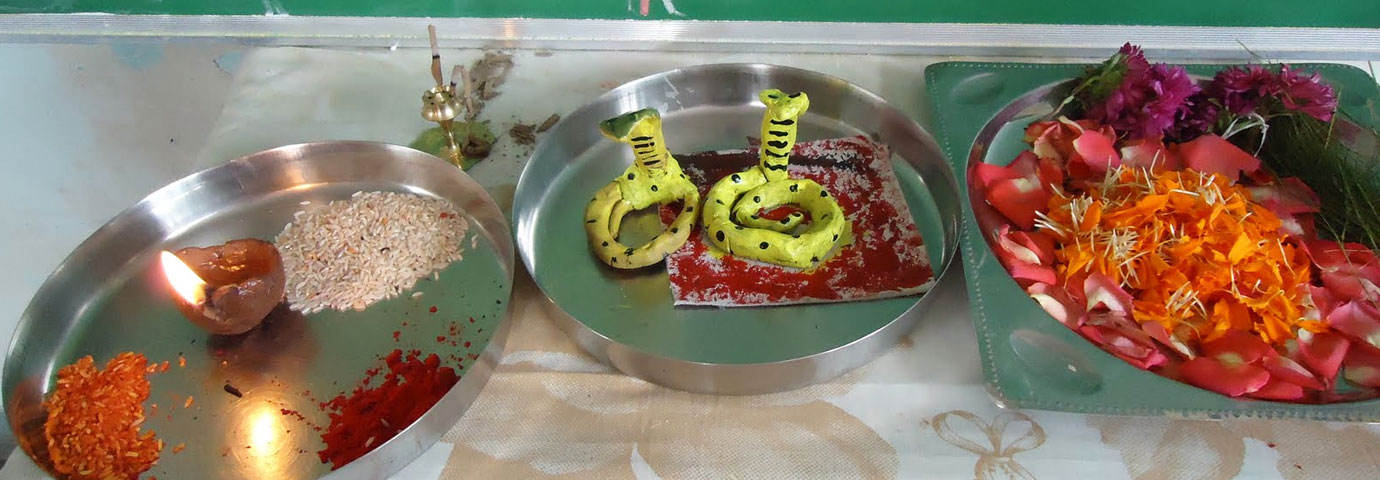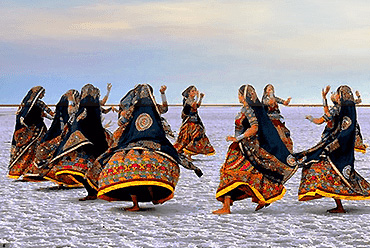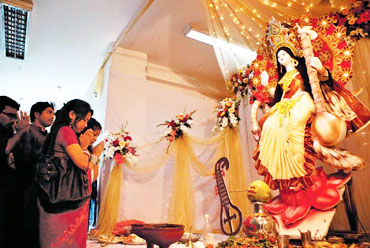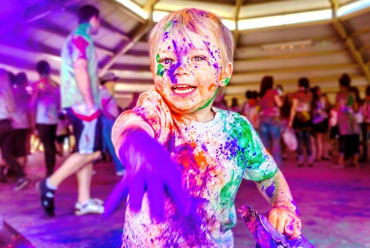India has a strange association with snakes. While certain regions of the country consider the reptile an ominous sign, others worship the cobra as a deity. The festival celebrated in honor of the Serpent God or Naag Devta is called Naag Panchami. Live cobras or their images are worshipped on this day.
Snake worship basically owes its origin to man's natural fear of the reptile. Hindu books are filled with stories and fables about snakes, and pictures and images of them can be seen at every turn. Worshippers search for holes where snakes are likely to be found, then they make periodic visits to these holes, placing near them milk, bananas, and other food that snakes might fancy.
The Naga culture was fairly widespread in India before the Aryan invasion, and continues to be an important sect in certain areas. After coming to India, the Indo-Aryans incorporated the worship of snakes into Hinduism. This is evident from the fact that the thousand-headed Anant is Vishnu's couch and also holds up the earth, while snakes play an ornamental role in the case of Lord Shiva.
Celebrations
Not every Hindu celebrates this festival, though this is one of the important festivals of the Hindu religion. The festival is especially dedicated to the Anant Naag or the Shesh Naag, who comforts the protector of the entire existence, Lord Vishnu. It is on the fifth day of the bright half of the month of Shraavan that Naag Panchami, the festival of snakes, is celebrated.
In the rural areas, the setting sun is a witness to processions of gaily-decorated bullock carts, trundling to nearby Shiva temples. Once there, excitement and merrymaking take over, lasting well into the night. The men also set free the snakes they had captured the week before.
Rituals
The reverence is especially pronounced during the Naag Panchami festival, usually in late July or early August. While the rest of the regions worship the Anant and Lord Shiva on this day, in Bengal, Manasa Devi is worshipped as the goddess of snakes.
As part of the traditions of the festival, women draw figures of snakes on the walls of their houses using a mixture of black powder, cow dung and milk. Then offerings of milk, ghee, water and rice are made to the snake god. On this day, farmers do not plough the fields for the fear of hurting a snake. It is believed that, as a reward for this worship, snakes will never bite any member of the family.
Legends
The Hindus believe that the cyclical molting makes snakes immortal, and eternity is thus represented in the form of a serpent eating its tail. The ritual of not tilling the land on Naag Panchami has its roots in the legend that, on this day, while tilling his land, a farmer accidentally killed some young serpents. The mother of these serpents took revenge by biting and killing the farmer and his family, except one daughter, who worshipped snakes. This act of devotion resulted in the revival of the farmer and the rest of his family.
Another legend speaks of Kaliya, the snake that inhabited the waters of the River Yamuna, whose venom was so vile that it poisoned the river and killed the crops and animals in the region. Krishna, one of Vishnu's avatars, killed Kaliya and liberated the people. Naag Panchami has been celebrated ever since in the region.
Regional Celebrations
The festival is celebrated all over the country, but mainly in the South, Maharashtra, and West Bengal. One can see snake charmers out on the streets on this day, with the snakes being offered milk by devotees. At Jodhpur in Rajasthan, huge cloth effigies of the mythical serpent are displayed at a colorful fair.
At Battis Shirala village in south Maharashtra, almost all the residents know the art of controlling snakes. On Naag Panchami, they go to houses in the other villages with dormant cobras and ask for alms and cloth. There, this festival also signifies the beginning of the preparations for the arrival of Lord Ganesh, a month later.
In Kerala, snake temples are crowded on this day and stone or metal icons of the cosmic serpent Anant or Sesh are worshipped. Altars in many Kerala homes have silver or copper cobra idols that are worshipped and offered milk and sweets as families pray for the welfare of their children and for prosperity.
In Punjab, the festival is celebrated in September-October and is called Guga Naumi. A snake made of dough is taken around the village in a basket, and an offering of flour and butter is made from each house. The 'snake' is then buried. In West Bengal and parts of Assam and Orissa, the snake deity worshipped on Naga Panchami is the goddess Manasa.
Places To Visit
The places to visit in order to witness this festival are the states of Maharasthra, Rajasthan, Kerala, Punjab, West Bengal, Assam and Orissa. The celebrations and festivities differ in every place, as do the rituals and related customs. However, one can definitely have a good idea of the importance the Hindus give to their festivals whether it is related to people, animals, or God.





